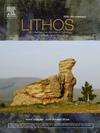The role of evaporite in iron oxide-apatite ore deposit formation: Constraints of the late Miocene Abovyan deposit, Armenia
IF 2.5
2区 地球科学
Q2 GEOCHEMISTRY & GEOPHYSICS
引用次数: 0
Abstract
Iron Oxide–Apatite (IOA) deposits are a notable source of iron, and, potentially, of phosphorus and rare earth elements (REE). The vast majority of these deposits are ancient (from ∼1900 to ∼100 Ma), and their original textures and mineral associations are overprinted by regional and local metasomatic/metamorphic processes. In the present paper, we provide new petrographic, mineralogical and geochemical data on the poorly studied Abovyan IOA deposit in Armenia, one of the world's youngest IOA deposits. The Late Miocene magnetite-apatite Abovyan deposit is hosted by a subvolcanic andesite body located in the volcanic zone of Gegham Highland. The ore mineralization is hosted in andesite and consists of disseminated magnetite‑carbonate blobs, breccia and massive magnetite-apatite bodies. Disseminated blobs mostly consist of magnetite-clinopyroxene-dolomite-hematite-calcite assemblages, whereas the mineralogical diversity increases toward the massive ore bodies with the appearance of Th- (thorite, monazite) and REE-rich (monazite, REE-silicates) minerals. Abundant inclusions of halite and sylvite were also found in magnetite from massive ore. Massive magnetite-apatite ore is depleted in Rb, Ba, K, Sr and HFSE and enriched in REE, Th, U and Pb relative to host andesite. The host rocks have more radiogenic 87Sr/86Sr ratios of ∼0.7053 than other volcanic rocks in the Gegham highland with ratios of ∼0.7042. The apatite from nine ores samples have even more radiogenic 87Sr/86Sr ratios of ∼0.706 for the same εNd values. These data allow us to conclude that ore formation is likely linked to liquid immiscibility triggered by the assimilation of Sr-rich and Nd-poor crustal material. The local source for such assimilated material is the K-rich evaporite of the Yerevan salt basin.
蒸发岩在氧化铁磷灰石矿床形成中的作用:亚美尼亚晚中新世Abovyan矿床的约束
氧化铁-磷灰石(IOA)矿床是铁的重要来源,也可能是磷和稀土元素(REE)的重要来源。这些矿床绝大多数是古老的(从~ 1900到~ 100 Ma),它们的原始结构和矿物组合是由区域和局部的交代/变质作用叠加而成的。本文为亚美尼亚Abovyan IOA矿床(世界上最年轻的IOA矿床之一)提供了新的岩石学、矿物学和地球化学数据。晚中新世Abovyan磁铁矿磷灰石矿床赋存于格干高原火山带的次火山安山岩体中。矿床赋存于安山岩中,由浸染状磁铁矿-碳酸盐团块、角砾岩和块状磁铁矿-磷灰石体组成。浸染状块状矿体主要由磁铁矿-斜辉石-白云石-赤铁矿-方解石组合组成,矿物学多样性向块状矿体方向增加,出现Th(钍、独居石)和富ree(独居石、ree -硅酸盐)矿物。块状磁铁磷灰石矿相对于寄主安山岩贫Rb、Ba、K、Sr和HFSE,富集REE、Th、U和Pb。寄主岩石87Sr/86Sr比值(~ 0.7053)高于Gegham高原其他火山岩(~ 0.7042)。在相同的εNd值下,9个矿石样品的磷灰石87Sr/86Sr比值为0.706。这些数据使我们得出这样的结论:矿石的形成可能与富含sr和贫nd的地壳物质同化所引发的液体不混溶有关。这种同化物质的本地来源是埃里温盐盆地的富钾蒸发岩。
本文章由计算机程序翻译,如有差异,请以英文原文为准。
求助全文
约1分钟内获得全文
求助全文
来源期刊

Lithos
地学-地球化学与地球物理
CiteScore
6.80
自引率
11.40%
发文量
286
审稿时长
3.5 months
期刊介绍:
Lithos publishes original research papers on the petrology, geochemistry and petrogenesis of igneous and metamorphic rocks. Papers on mineralogy/mineral physics related to petrology and petrogenetic problems are also welcomed.
 求助内容:
求助内容: 应助结果提醒方式:
应助结果提醒方式:


